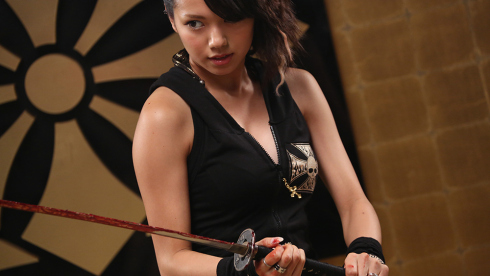An alarmingly catchy toothpaste commercial is the only thing you’ll care to remember from “Why Don’t You Play in Hell?,” a tedious, over-the-top gorefest that finds prolific Japanese auteur Sion Sono veering into sub-Tarantino B-movie-pastiche territory. Relentlessly jokey, strenuously deranged and conspicuously pleased with itself, this overstuffed yarn about two warring yakuza clans and an amateur filmmaking crew is an empty exercise in carnage maximus. Following last year’s “The Land of Hope,” a surprisingly sober-minded drama addressing the Fukushima nuclear disaster, Sono has delivered a picture geared exclusively toward his most grindhouse-oriented fans, though even they may leave feeling a bit let down. Bound for Toronto’s Midnight Madness sidebar and Austin’s Fantastic Fest, “Hell” will play in North American theaters next year via Drafthouse Films.
Get Venice Film Festival News and alerts free to your inbox
According to the press materials, Sono wrote the script 17 years ago but only dusted it off recently; he didn’t change much (pity), except to weave in a “requiem for 35mm” as acknowledgment of the ongoing ascendancy of digital filmmaking. And the film does open with a promising burst of cine-happy nostalgia as aspiring movie director Don Hirata (Hiroki Hasegawa, irritating) flashes back to a moment 10 years earlier, when he gathered together a group of enthusiastic, 8mm camera-wielding wannabes and dubbed them the Fuck Bombers. (Why? It doesn’t matter.) Their apparent method, suggesting a bizarre fusion of documentary and flash-mob techniques, is to go out and film whatever mayhem and carnage they can find.
And they find plenty, as they happen to be in the vicinity of a vicious gangland war between yakuza boss Muto (Jun Kunimura) and rival clan leader Jun Ikegama (Shinichi Tsutsumi). When Ikegama and his men invade Muto’s home to finish him off, they instead encounter Muto’s berserk, bloodthirsty wife, Shizue (Tomochika), who, after unleashing the first of the film’s many blood-soaked setpieces, is sentenced to a decade in prison for murder. One of the event’s more tragic repercussions is that it wrecks the acting career of the Mutos’ adorable young daughter, Mitsuko, whose aforementioned toothpaste commercial gets yanked from the airwaves in response to the scandal.
Ten years later, Shizue is about to be released, and she’s eager to see Mitsuko (Fumi Nikaido) make her long-overdue bigscreen debut in a small independent film. But bratty teen Mitsuko has apparently gone all Lindsay Lohan on the shoot and gotten herself kicked off the production (which at least raises the interesting question of what “The Canyons” director and Venice Horizons jury president Paul Schrader will make of Sono’s film). Here to save the day, or ruin it, or whatever, are the Fuck Bombers, who hit upon a nonsensical plan to restore Mitsuko to indie stardom, settle the yakuza war and make a totally kick-ass action movie to boot.
And indeed, this is one gonzo schlockfest that takes pains to wear its movie love on its sleeve, like “Kill Bill” without the style or finesse; one character even spends most of the film in Bruce Lee’s yellow tracksuit. Some of the other cinematic references skew higherbrow, as when a bright red balloon ascends into the sky, or when a sequence is overlaid with a contempo cover version of Handel’s “Sarabande” from “Barry Lyndon.” But for all his mixing and remixing of pop favorites, Sono doesn’t seem to take much delight in the process, and his boredom proves contagious; this is a perfunctory pastiche that crucially lacks the sense of delirium that would bring its artificial world to life.
A trim 90-minute version of “Why Don’t You Play in Hell?” would probably be just as pointless but fractionally less dull; at its current “director’s cut” length of 119 minutes (sans closing credits), Sono’s chaotically edited story manages to be at once convoluted and threadbare as it forces its oil-and-water parallel narratives to converge. Idiot catchphrases are repeated for no reason; performances are cranked up to shouty, migraine-inducing volumes; scenes seem to be layered in such a way as to prevent rather than aid comprehension. The only time the pic seems to slow down is when it wants the audience to savor a particularly sadistic setpiece, as when Mitsuko confronts an ex-b.f., proving the old maxim that revenge is a dish best served cold and with a side order of oral mutilation.
There is, perhaps, the faintest whiff of an auto-critique at the climax — a film-within-a-film bloodbath of such numbing, grotesquely cartoonish proportions that it could be commenting on how violence-obsessed filmmakers are out of touch with the reality of the imagery they’re exploiting, or perhaps how the rise of digital cinema has only quickened the medium’s dehumanization. But a flicker of self-awareness doesn’t make this hollow provocation any less of a self-deflating bore.

